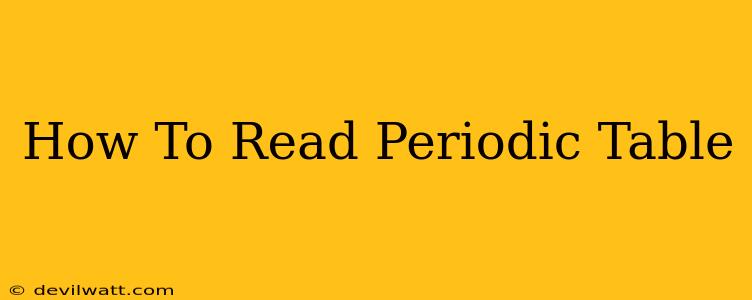The periodic table. That intimidating grid of elements that seems to hold the secrets of the universe. But fear not! This guide will break down how to read the periodic table, making it accessible and understandable for everyone, from beginners to those looking to refresh their knowledge.
Understanding the Basics: Rows, Columns, and Atomic Numbers
The periodic table organizes all known chemical elements in a structured way. Let's start with the fundamentals:
-
Rows (Periods): Each row represents a principal energy level, indicating the number of electron shells an atom of that element possesses. As you move across a row, the number of electrons increases, influencing the element's chemical properties.
-
Columns (Groups or Families): Elements in the same column share similar chemical properties because they have the same number of valence electrons – the electrons in the outermost shell. These valence electrons are crucial in chemical bonding. For example, Group 18 (noble gases) are famously inert because they have a full outermost electron shell.
-
Atomic Number: This is the most important number on the periodic table. Located at the top of each element's square, the atomic number represents the number of protons in the nucleus of an atom. Since atoms are electrically neutral, it also indicates the number of electrons. The atomic number uniquely identifies each element.
Key Information in Each Element's Square
Each square in the periodic table provides crucial information about the element. This usually includes:
- Element Symbol: A one or two-letter abbreviation, such as H for hydrogen or O for oxygen.
- Element Name: The full name of the element, like Hydrogen or Oxygen.
- Atomic Number: As discussed earlier, this is the number of protons.
- Atomic Mass: This is the average mass of an atom of the element, taking into account the different isotopes (variations in neutron number) of that element.
Deciphering the Periodic Table's Structure
The periodic table isn't just a random arrangement; it's cleverly designed to highlight trends in elemental properties. Understanding this structure is key to interpreting the table:
-
Metals, Nonmetals, and Metalloids: The table broadly categorizes elements into metals (typically on the left), nonmetals (on the right), and metalloids (along the "staircase" line separating metals and nonmetals). Metals are generally shiny, conductive, and malleable, while nonmetals tend to be brittle and poor conductors. Metalloids exhibit properties of both metals and nonmetals.
-
Alkali Metals (Group 1): Highly reactive metals that readily lose one electron.
-
Alkaline Earth Metals (Group 2): Reactive metals that readily lose two electrons.
-
Halogens (Group 17): Highly reactive nonmetals that readily gain one electron.
-
Noble Gases (Group 18): Inert gases with full electron shells, making them very stable and unreactive.
-
Transition Metals: Elements in the central block of the table, known for their variable oxidation states (charges) and colorful compounds. Many are crucial for biological functions and industrial applications.
-
Lanthanides and Actinides: These elements, often placed at the bottom of the table, are f-block elements with similar chemical properties. Many actinides are radioactive.
Practical Applications and Further Exploration
Learning to read the periodic table is a foundational skill in chemistry and related fields. It allows you to:
- Predict chemical reactions: Understanding an element's group and period gives clues about its reactivity and how it will interact with other elements.
- Identify properties of elements: Based on their location, you can estimate an element's properties such as conductivity, reactivity, and state at room temperature.
- Understand the building blocks of matter: The periodic table is a fundamental tool in understanding the composition of everything around us.
The periodic table might seem complex at first glance, but with practice and a systematic approach, it becomes a powerful tool for understanding the elements and their interactions. Don't hesitate to explore online resources, educational videos, and interactive periodic tables to enhance your understanding further. With consistent effort, you will become confident in navigating this fascinating chart of chemical elements.

